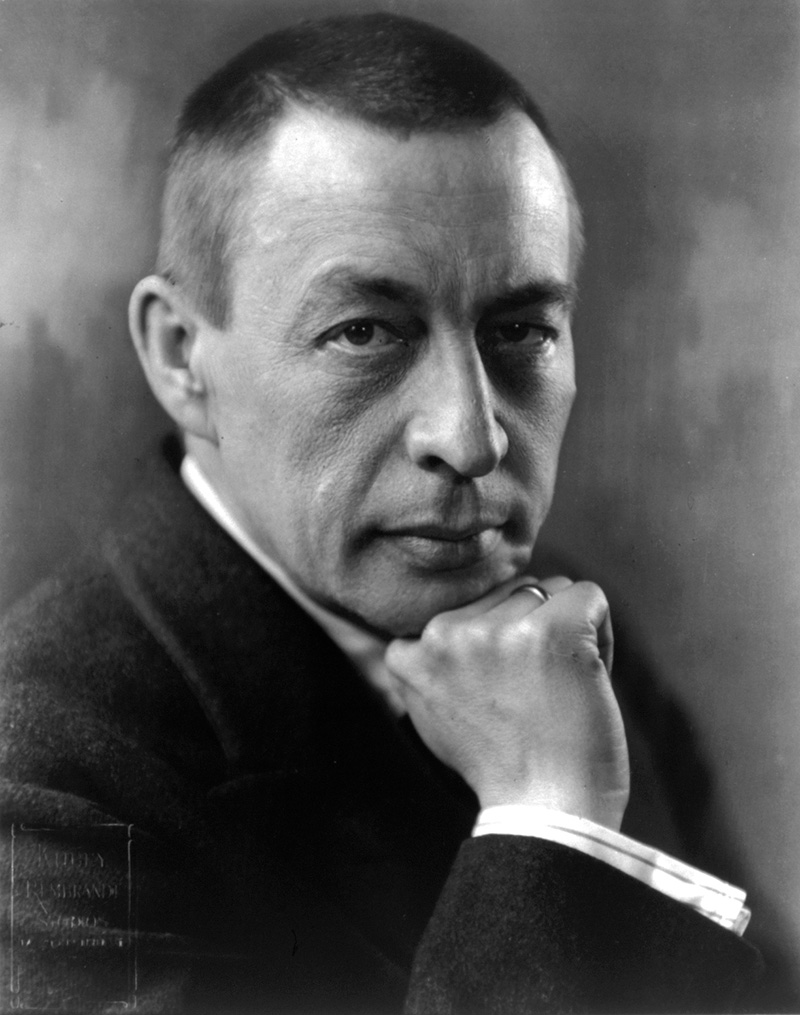Sergei Rachmaninoff

- Born: March 20 [April 1, New Style], 1873 in Oneg, near Semyonovo, Russia
- Died: March 28, 1943 in Beverly Hills, California
Vocalise
- Composed: The version for soprano and piano was composed between March and September 21. 1915. The composer subsequently orchestrated the work.
- Premiere: January 24, 1916 in Moscow with Antonina Vasilevna Neshdanova, soprano and Rachmaninoff, piano.
- Instrumentation: 2 flutes, 2 oboes, English horn, 2 clarinets, 2 bassoons, 2 horns and strings
- CSO notable performances: First Performance: April 2000, Jesús López Cobos conducting. Most Recent: February 2004 on a Cincinnati Pops subscription program conducted by Erich Kunzel. Recording: Recorded by the CSO for the album Rachmaninoff: Symphony No. 2, Vocalise released by Telarc in 2001 conducted by Jesús López Cobos.
- Duration: approx. 7 minutes
Rachmaninoff entered into an extended correspondence with the young Poet Marietta Shaginyan in February 1912. Although no personal intimacy developed between them, his letters to her are more revealing than those to anyone else at the time, even though she concealed her identity for several months. He freely wrote to his anonymous friend, known at first only as “Re,” about his innermost thoughts and feelings, and about his lack of self-confidence. His trust of her extended to his asking her to send him some texts that he might set as a cycle for soprano and piano. “Whether the author is contemporary or dead makes no difference,” he wrote, “provided that the piece is original and not a translation and no more than eight to 12 lines in length, or at most 16. And another thing: the mood should be sad, rather than gay; bright tones do not come easily to me.”
The composer disliked most of the verses his new friend sent, but he found several that he truly liked and from them completed 13 songs by the middle of June. In appreciation for her help, Rachmaninoff dedicated the first song to Shaginyan, although the others were inscribed to various singers.
The set was not complete, however. The composer felt it needed one final song, but it was three more years before he composed it. For this song he did not turn to a text suggested by Shaginyan, or to any other text. Rather, he created a song without words, which he dedicated to the coloratura soprano Antonina Vasilevna Neshdanova. The singer was disappointed by the absence of words, but the composer replied, vaguely, “What need is there of words, when you will be able to convey everything better and more expressively than anyone could with words, just by using your voice and interpretation?”
Rachmaninoff aptly called this wordless song “Vocalise.” A vocalise is, according to musicologist Owen Jander, “a textless vocal exercise or concert piece to be sung on one or more vowels.” There were numerous vocalizes published with piano accompaniments in the first half of the nineteenth century. They were intended to offer, in the words of one composer of vocalizes, “the pupil a union of all the difficulties of song” without having to concentrate on the projection of text while focusing on technical and musical challenges. Although many pre-twentieth-century vocalises are quite musical, they were thought of as exercises and hence rarely performed in public.
Late on, however, a few composers began to take an interest in the genre as a means of making genuine music. There were sporadic nineteenth-century compositions in which a wordless voice was used like a solo instrument, such as a flute or violin, accompanied by a piano. By the early twentieth century, major composers such as Fauré, Ravel, Casella and Respighi were composing vocalizes as concert pieces. Hence Rachmaninoff’s “Vocalise” fit well into this increasingly popular genre, which eventually led to still more ambitious works like the Sonata-Vocalise and Suite-Vocalise by Rachmaninoff’s compatriot Nicolai Medtner, and also Reinhold Glière’s Concerto for Coloratura and Orchestra. In addition, wordless solo voices appear within the orchestral fabrics of Nielsen’s Third Symphony, Vaughan Williams’ Pastoral Symphony, and Villa Lobos’ Bachianas Brasileiras Number 5, and wordless choruses are featured in Debussy’s Sirènes, Ravel’s Daphnis et Chloé, and Holst’s The Planets.
A few months after the completion of the fourteenth song of Opus 34, the soprano Nezhdanova introduced “Vocalise” along with some other Rachmaninoff songs with the composer at the piano. “Vocalise” made an immediate impression, far overshadowing the other Opus 34 songs. Impressed with the work’s instant popularity, the composer’s friend Nikolai Struve suggested an orchestra version (without voice), which the composer made, along with versions for solo violin and solo cello. In these various guises Vocalise has become widely performed and loved.
—Jonathan D. Kramer